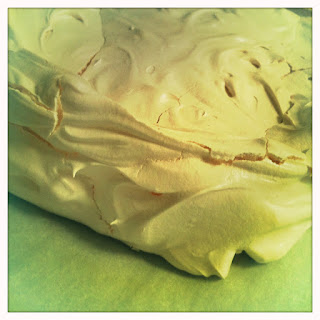Australians and New Zealanders regard each other as family. But like any family there are issues of family contention. One of these is just who invented the pavlova. This is a hotly debated topic - whole books have been devoted to where the creation of a meringue base topped with cream and fruit was given its name in honour of the ballerina Anna Pavlova. It is one of those long standing family arguments with no way of determining an answer, but I think we can all be thankful for the result.
My family is full of foodies, yet there are surprisingly few desserts that everyone really enjoys. Pav is one of those few, however everyone likes their own version of the toppings, so we tend to serve it in a modern "deconstructed" manner. Like a production line, each person selects their desired level of cream and/or fruit- or in my sister's case just eats the meringue on its own.
The trick with pavlova is to beat it really, really well. I found I had issues with my pavs going flat until I got a mix master and beat them much more. There is usually at least 20 minutes beating time on maximum speed these days when I make a pavlova. The other tricks are to have your egg whites at room temperature, and let the pav cool in the oven, with the door closed but oven turned off for awhile and then by just opening the door a crack.
Ideally a pavlova has a crisp outside shell filled with a soft marshmallowy filling. Traditionally a pavlova is topped with whipped cream, then arranged with strawberries, kiwi fruit, banana and passionfruit, but you can really top it with anything you like - S is a big fan of shaved chocolate.
 |
| All beaten up and ready for the oven |
Pavlova
6 egg whites at room temperature
375g caster sugar
1.5 tsp vanilla extract
1.5 tsp white vinegar
Beat egg whites until very stiff. Gradually add the sugar, vanilla and vinegar. Continue to beat until very thick.
Pile your meringue on an oven tray lined with baking paper (or a pavlova plate if you have one). Remember they usually spread a bit. Smooth roughly into a circle adding any decorative swirls you like in the meringe then bake at 120 degrees for an hour.
Cool in the oven with the door closed for quite a long time, then just open it a crack
Just before serving top with whipped cream and fruit of your choice (usually mixed berries marinated in cointreau and a little sugar in my family).
 |
| Yes, I opened the door too soon, hence the cracking. |

I am still on the lookout for the perfect pav recipe, so I shall try this one. I must not have been beating mine for long enough previously.
ReplyDeleteHave a go, it is my Aunt's (who is a chef) recipe. But really beat it for AGES. And let it cool in the oven. Those are the two key tricks I think.
DeleteYou know, I have never made pavlova. Isn't that ridiculous?! Pretty much no one in my family likes cream, so I think it was one of those things we just didn't have growing up (although of course you could make it without cream toppings).
ReplyDeleteWow! I would make several every year, they are a staple for us. Lemon curd is a great cream alternative that also goes really well with the meringue and the fruit.
DeleteYUM! For a simple every day dessert too, I love making little meringue nests which you can just top with fruit and cream. Kind of like a convenient DIY pav!
ReplyDeleteI love the individual ones too Cat, however I find I never quite manage to get the middle as soft and marshmallowy as I do with a big one.
Delete